 valleedulot.com - The lot Valley - The fortified towns
valleedulot.com - The lot Valley - The fortified towns
Observatoiredes crues La vie de
la rivière Virtual visits French version English version

Back to home| What to do in the Lot Valley | Visits | The fortified towns
The fortified towns
The Top 5 towns in the Lot Valley
Cahors (Lot)
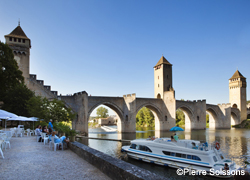 In a meander of the Lot, the Lot's little beauty. It cuts a fine figure, with its arcade houses, bricks and timber frames, its cathedral and its Valentré bridge (both of which are UNESCO World Heritage sites).
In a meander of the Lot, the Lot's little beauty. It cuts a fine figure, with its arcade houses, bricks and timber frames, its cathedral and its Valentré bridge (both of which are UNESCO World Heritage sites).
Here is a good idea : try exploring it as you make your way through its secret gardens, recent creations, quite out of the ordinary and in different colours. These are recent creations, inspired by the Middle Ages, a time when Cahors knew fame and prosperity. To explore these 30 little gardens one after the other, follow the bronze acanthus leaves set in the pavement.
Figeac (Lot)
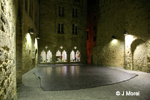 Figeac, a "Town of Art and History". Its history goes back well over a thousand years. By the 13th-14th C., Figeac was a thriving centre of trade and commerce, whose rich merchants were to be found all over Europe and around the Mediterranean. This enabled some of the most ornately-decorated private houses in the Lot to be constructed here; many of which still remain. A stroll around the old town is at once a delight and an education.
Figeac, a "Town of Art and History". Its history goes back well over a thousand years. By the 13th-14th C., Figeac was a thriving centre of trade and commerce, whose rich merchants were to be found all over Europe and around the Mediterranean. This enabled some of the most ornately-decorated private houses in the Lot to be constructed here; many of which still remain. A stroll around the old town is at once a delight and an education.
A must : the World Scripture Museum
(This fascinating museum, dedicated to the world's major writing systems, occupies the house in which was born Jean-François Champollion, who cracked the lost code of Egyptian hieroglyphics in the early 19th C. )
Mende (Lozere)
The capital of the Gévaudan brushes shoulders with the Cévennes. Its history goes back to the Middle Ages, with its cathedral like a Gothic vessel. its houses with their projecting stories and its 13th century bridge. Know also for sports (it has been used to host several marathons and enduro), Mende was the city stage of Tour de France in 1995 and 2010.
Saint Flour (Cantal)
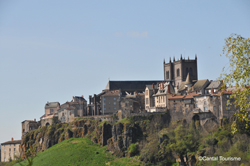 Built on a spur, the medieval city "Land of art and history" is imposing with its Gothic cathedral and its lava buildings. For lovers of old stone work, a treat : Renaissance façades and courtyards, medieval stalls and an indoor market set up in a former collegiate church.
Built on a spur, the medieval city "Land of art and history" is imposing with its Gothic cathedral and its lava buildings. For lovers of old stone work, a treat : Renaissance façades and courtyards, medieval stalls and an indoor market set up in a former collegiate church.
Tourist Office information website
Villeneuve sur Lot (Lot-et-Garonne)
In all its spendlour on the banks of the Lot, this river fortified town was built by Alphonse de Poitiers, brother of Saint Louis, in the 13th century. It has since lost its fortifications, but kept its towers, one of which is the Pujol tower, its timber framed houses and its central square, lined with leafy canopies or arcades. It is here that a lovely market is open for business on Tuesdays and Saturday mornings. A contemporary of the Pont Valentré in Cahors, the Pont-Vieux makes along with the Bout-du-Monde chapel a perfect postcard. Villeneuve sur Lot is also the Prune capital.
A choice holiday destination with its water sport centre, a distinctive heart to the town and some pretty places to visit, such as its stud farm or the Gayac Mill, the museum of Fine Arts
Visit Villeneuve sur Lot website
Some 35 km upstream of Cahors the village of St. Cirq Lapopie stands high above the Lot perched like a sentinel on a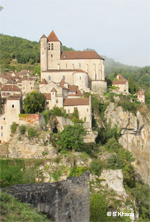 n outcrop of rock. From early times, this was the site of a fortress which stood guard over the valley and kept close watch on all the traffic passing up and down the river.
n outcrop of rock. From early times, this was the site of a fortress which stood guard over the valley and kept close watch on all the traffic passing up and down the river.
More information on Saint Cirq Lapopie Tourist Office Website
Puy-L’Evêque (Lot)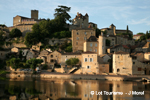
Standing on the left bank of the Lot, it was a very bustling and prosperous port. It has still kept some of its picturesque little streets, lined with Renaissance houses, chapels, 14th century Gothic building.
More information on the French tourist office website
Monflanquin (Lot-et-Garonne)
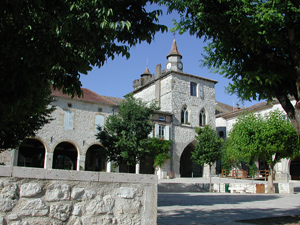 Perched on top of a hill, the fortified town of Monflanquin was built in 1256 by Alphonse de Poitiers. Its fortifications, including eleven towers and gates, were dismantled in 1632 under the orders of Cardinal Richelieu. The town's oval layout contrasts with the regularity of its streets, which are punctuated by narrow alleys and covered walkways and corridors between the houses. The central square framed by arcades and the characteristic buildings, such as the Maison du Prince Noir or the Saint Andrée church, have made Monflanquin into one of France's most beautiful villages ("Plus beaux villages de France" classification).
Perched on top of a hill, the fortified town of Monflanquin was built in 1256 by Alphonse de Poitiers. Its fortifications, including eleven towers and gates, were dismantled in 1632 under the orders of Cardinal Richelieu. The town's oval layout contrasts with the regularity of its streets, which are punctuated by narrow alleys and covered walkways and corridors between the houses. The central square framed by arcades and the characteristic buildings, such as the Maison du Prince Noir or the Saint Andrée church, have made Monflanquin into one of France's most beautiful villages ("Plus beaux villages de France" classification).
Pick any carreyrou, (little street), and you might come across Janouille, the funny old troubadour jester : just follow him, he’s the best guide for the city!
Around : the fortified towns of Tournon d’Agenais, Villeréal, Laparade.
Penne d’Agenais (Lot-et-Garonne)
On its spur, the cité defied both Simon de Montfort and the English during the Hundred Years War. Following the last siege, the castle on the rock was demolished ; only the base of the keep remains. The town gate, the Richard gate and the Ferracap gate are remains of the former city wall, built between 1194 and 1330.The air is thick with History : fortified doors, little streets with their steps, timber framed houses. Some fine restaurants and master craftsmen.
On the site of earlier chapels commemorating a miraculous appearance of the Virgin Mary, the Basilica of Notre-Dame-de-Peyragude was built in neo-byzantine style (1897-1948) rather like the Sacré Coeur in Paris. There are pilgrimages here each 15 August.
Luzech (Lot)
A quite exceptional site : the cité is like a peninsular, set in a very tight bend on the Lot. Everything there reminds you of the life of the boatmen, the picturesque little streets and the chapel with votive offerings.
Tourist Office contact +33 5 65 20 17 27
`
Pujols (Lot-et-Garonne)
Yet another village with a view! A little gem above the valley of the Lot, this most beautiful of French villages has kept its medieval heritage intact. A farmer’s market in the wooden market hall.
Tourist Office contact : +33 5 53 36 78 69
Montcabrier (Lot), such a pretty village and the 14th century Saint-Louis church
Castelfranc (Lot) and its garden of fragrances.
Villecomtal (Aveyron) in red sandstone and the land of Enfarinats : at the beginning of the 19th century, people would powder their hair with flour as a sign of fidelity to the old Régime !
Clairac (Lot-et-Garonne)
A port which was in use in the 18th century, has kept its boatmen and Coopers’ houses, tobacco driers, a pretty washing fountain. Above the Lot. Montesquieu was a fan of all these places.
Tourist Office contact : +33 5 53 88 71 59
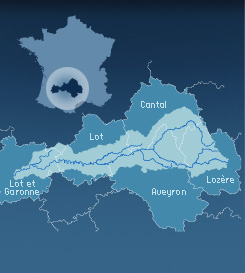
 :
: 




